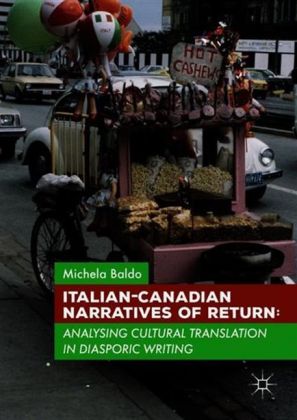In her Italian-Canadian Narratives of Return. Analysing Cultural Translation in Diasporic Writing (Palgrave Macmillan, 2019, pp. 436) Michela Baldo maps out the theoretical questions posed by diaspora studies in a rich and compelling way.
In the Introduction to the book, she clearly outlines her approach and provides an interesting meditation on “translation as a metaphor for diasporic writing.” She posits that the migrant’s condition is deeply rooted in multilingualism, forcing the diasporic subject to constantly live in translation. This is a fact that, however, needs cultural explication, that is, that needs to become socially explicit by means of critical interrogation. Diaspora studies can offer such an insight and analysis because of their innate interdisciplinary character and tools.
In recent years, the emergence of a “transnational” approach has allowed scholars to understand, through the analysis of literary texts, how to deconstruct exclusivist paradigms. The case of Italian migrant writing, which the book describes in a significant and captivating fashion, reveals the potential benefits to this field of studies coming from the transnational approach, especially as concerns the notion of canon.
Including and thematising “hyphenated” works – such as, for example, Italian-Canadian ones – within the national literary canon, provides a considerable challenge. Specifically, the task is to demystify “the oppositional paradigm between canonical literature and literature at the frontier,” which an autonomistic and “monocultural” ideology deems to be minor, and often alien to the cultural history of the nation.
The aim is not to simply include these works within the literary paradigm; rather, it is to develop “a model that draws on studies of cosmopolitanism, global migration and translation, and which understands Italian language and Italian literary landscapes as spaces with indistinctive margins, with no separations between an alleged homogeneous centre (Italy) and an extraneous periphery (Italies outside Italy).” Furthermore, the concept of diaspora, which increasingly defines the dynamic relation existing between texts, meanings and cultures, makes it possible to highlight all the limitations of a “purely thematic approach to migrant writing” and to open the debate to issues that go beyond merely taxonomical questions.
In addition, Michela Baldo’s analysis tries to develop a further argument concerning the role of translation, which she elaborates on in the chapters dedicated to the single literary works. She argues that “we can conceive multilingual writing as a form of translation. Translation can thus be conceptualised not only as a metaphor for migration and diaspora, but also as a metaphor for writing.”
To see the act of writing as an extension of the diasporic condition is the most original contribution of the book for two reasons. The first, more general, concerns her conceiving of the literary text as a profoundly dynamic mechanism, open, as it were, to linguistic solutions. These texts emerge from the ever-changing historical conditions generating them, a condition of “heterolingualism“ or plurilingual mimesis, as she defines it. The second, more specific reason interrogates and substantiates such a concept by focusing on those literary experiences endorsing such a mobile view of literature. Baldo sees them in the “narratives of return” by “Italian-Canadian writers.” The latter, she contends, “use the switch from one language to another as a narrative device. This movement of going back and forth between different perspectives in an attempt to find an authentic voice can be considered a sort of cyclical return.”
A purely narratological analysis of this “voice” can only technically observe a certain presence; for Baldo, however, a deeper reflection is necessary, one which goes straight to the core of the very idea of narration as an implicit act of translation. In particular, “code-switching represents the meeting point between translation and narration,” that is, a sort of signification space where the different voices in the texts can find articulation in a diasporic perspective.
This volume is also a useful overview of the themes and issues that are still unresolved within the field of “Italian-Canadian writing.” The case studies she investigates are quite significant, as they represent “a group of selected writings translated into Italian […] by Italian-Canadian writers Nino Ricci, Mary Melfi and Frank Paci,” works that “deal with the notion of return, and their translation has been framed in terms of return.” She therefore proposes an analytical model that understands the switch from one language to the other as the arrangement of a semantic scene, whose rhetorical or stylistic detail is strictly related to the construction of a cultural identity.
Here we find another objective of the book, ultimately that the concept of translation should be conceived of in social terms, since it is the by-product of a network of not simply textual, but also material and collective relations. These are fuelled by a narrative drive that anticipates, through translation, a newfound way to represent the social condition of diaspora. Surely, the merit of Michaela Baldo’s work is to demonstrate how the narratological inquiry – here operating meticulously – should go hand in hand with a broader cultural examination.
Marco Gatto is Adjunct Professor of Literary Theory at the Department of Humanities – University of Calabria. Author of seven volumes and several articles, his last book is Resistenze dialettiche. Saggi di teoria della critica e della cultura (Rome, Manifestolibri, 2018).




